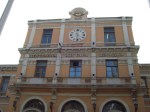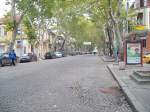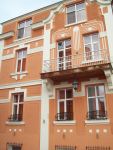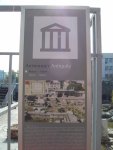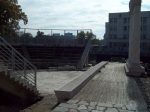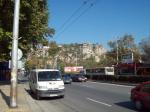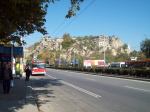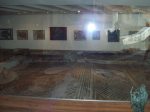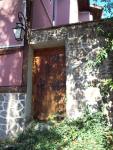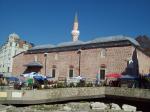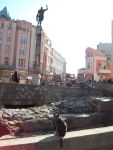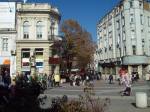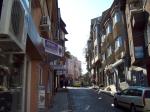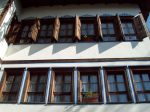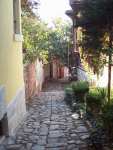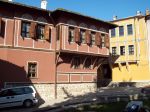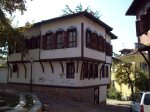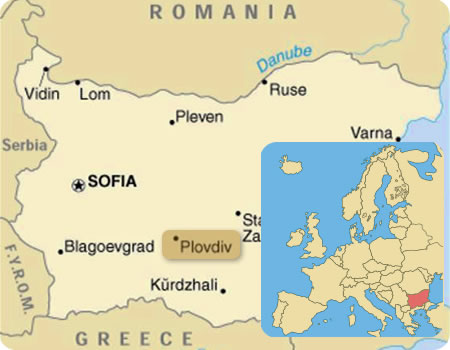
Plovdiv (Bulgarian: Пловдив) is the second-largest city in Bulgaria with a population of 381,738. Known in the West for most of its history by the Greek name Philippopolis, it was originally a Thracian settlement before becoming a major Roman city. In the Middle Ages, it retained its strategic regional importance, changing hands between the Byzantine and Bulgarian Empires. It came under Ottoman rule in the 14th century. In 1878, Plovdiv was made the capital of the autonomous Ottoman region of Eastern Rumelia; in 1885, it became part of Bulgaria with the unification of that region and the Principality of Bulgaria.
Plovdiv is situated in the southern part of the Plovdiv Plain on the two banks of the Maritsa River. The city has historically developed on seven hills, some of which are 250 m high. Because of these seven hills, Plovdiv is often referred to in Bulgaria as „The City of the Seven Hills”.
The Slavs had fully settled in the area by the middle of the 6th century and changed the ethnic proportions of the region. With the establishment of Bulgaria in 681 Philipopolis became an important border fortress of the Byzantine Empire. It was captured by Khan Krum in 812 but the region was fully incorporated into the Bulgarian Empire in 834 during the reign of Khan Malamir. It remained in Bulgarian hands for a relatively short time until it was reconquered by the Byzantine Empire in 855-856.
Under tsar Simeon the Great (893–927) the city and most of the Byzantine possessions in the Balkans were conquered by the Bulgarian Empire. The city remained in Bulgarian hands under Simeon’s son, Peter I (927–969).
In 970 the Asian army of the Byzantine Empire under the eunuch Peter was destroyed by the Bulgarians near Plovdiv. The city again came to be known as Philippopolis and became Byzantine in character.
Byzantine rule was succeeded by that of the Latin Empire in 1204, and there were two short interregnum periods as the city was twice occupied by Kaloyan of Bulgaria before his death in 1207. In 1208 Kaloyan’s successor Boril was defeated by the Latins in the Battle of Philippopolis.
Under Latin rule, Plovdiv was the capital of the Duchy of Philippopolis governed by Renier de Trit, and later on by Gerard de Strem. Bulgarian rule was reestablished during the reign of Ivan Asen II between 1225 and 1229. In 1263 Plovdiv was conquered by the restored Byzantine Empire and remained in Byzantine hands until it was re-conquered by George Terter II of Bulgaria in 1322. Byzantine rule was restored once again in 1323, but in 1344 the city and eight other cities were surrendered to Bulgaria by the regency for John V Palaiologos as the price for Ivan Alexander of Bulgaria‘s support in the Byzantine civil war.
In 1364 the Ottoman Turks under Lala Shakhin Pasha seized Plovdiv. The Turks called the city Filibe. It was the capital of Rumelia until 1382 when the Ottomans captured Sofia which became the main city of the province.
Plovdiv survived as one of the major cultural centers for Bulgarian culture and tradition. The name Plovdiv first appeared around that time and is derived from the city’s Thracian name Pulpudeva (assumed to be a translation of Philippopolis, from Pulpu = Philippou and deva = city), which was rendered by the Slavs first as Pəldin (Пълдин) or Pləvdin.
The city was liberated from the Ottomans during the Battle of Philippopolis in 1878.
The climate is temperate with mild influence from the Mediterranean Sea and a huge temperature range between summers and winters. Summers are generally extremely hot and dry. On average the city experiences 38 days of temperatures over 30c and 7 days of over 40c a year. Winters are cold, but can sometimes be accompanied by a Mediterranean influence, which can on occasions result in huge temperature jumps within just a few days.
Tourist attractions:
The Rennaissance town of Old Plovdiv was built during the 19th century. Today it has survived as a unique architectual ensemble on the three hills. Its houses reveal the remarkable urban culture of Bulgarian builders, as well as their sense of harmony and their creative power. The brilliant architecture with its noble, stylish simplicity could be called rightfully the Baroque of Plovdiv.
The Church of the Holy Mother of God (Bulgarian: Църква Света Богородица) is a Bulgarian National Revival church in Bulgaria‘s second largest city Plovdiv. The church is situated in the Old town of Plovdiv on one of the city’s seven hills, Nebet Tepe.
A small church existed on that place since the 9th century. The church was renovated in 1186 by the bishop of Plovdiv Constantine Pantehi and it became part of a monastery. Both the church and the monastery were destroyed when the Ottoman Turks conquered the city in 1371 during the course of the Bulgarian-Ottoman Wars. The current edifice was constructed in 1844 as the main church of the city.
The Plovdiv Roman Stadium is among the largest Roman structures in the Balkans. The massive edifice is 180 long and had a capacity of over 30,000. It is believed that it was built during the reign of Septimus Severus (193-211).
Today, the stadium is located in the centre of the city, under the main trade centres. Only part of the edifice can be observed from the Dzhumayata Square, the larger portion is still underground. Further excavation would be very difficult and costly.
The stadium is one of the many Roman remains in the city which include the best preserved Theatre in the Balkans; the ruins of the Agora; a second theatre; remains of an aqueduct, temples and villas with some magnificent frescoes.
The Plovdiv Antique theater is situated in the city center of Plovdiv. The Theater stands between the south-western slope of the Dzhambaz Tepe and the Taxim tepe hill within the old town, and is a major tourist attraction for travelers coming to the area.
The theatre was built in the 2nd century AD under the orders of Trajan the Roman Emperor at this time, and is one of the many surviving Roman constructions in Bulgaria today.
Built with around 7,000 seats, each section of seating had the names of the city quarters engraved on the benches so the citizens at the time knew where they were to sit. The theater was damaged in the 5th century AD by Atilla the Hun.
The theater was only found in the early 1970s due to a landslide, this caused a major archeological excavation, including the removal of 15 feet of earth covering what was left hidden by the landslide.
„Şahabettin İmaret” Mosque, built in XVth century.
The Cathedral of St Louis (Bulgarian: катедрала „Свети Лудвиг“, katedrala „Sveti Ludvig“) is a Roman Catholic cathedral in the city of Plovdiv, Bulgaria. The cathedral was constructed in the 1850s, during the time of vicar Andrea Canova. The first organ in Bulgaria was installed in the cathedral in 1861, later substituted with a newer and larger one. A fire severely damaged the cathedral in 1931 and destroyed the wood-carved ceiling. The cathedral was reconstructed, with Krastyo Stamatov creating the frescoes and Kamen Petkov being the main architect. The cathedral was once again inaugurated on 8 May 1932. Architecturally, it features an eclectic combination of Neoclassicism and Neo-Baroque.
The belfry was built in 1898 and was equipped with five bells cast in the German city of Bochum, a gift from Pope Leo XIII. A new 12-stop pipe organ was installed in 1991.
Armenian Apostolic Church St. George (Kevork) in the Old Town.
Northern district (Bulgarian: Район Северен) is a district of Plovdiv. The district is located on the northern bank of theMaritsa river.
The Archaeological Museum was established in 1882 as a People’s Museum of Eastern Rumelia. In 1928 the museum was moved to a 19th century edifice on Saedinenie Square built by the famous Plovdiv architect Josef Schnitter. The museum contains a rich collection of Thracian art. The three sections „Prehistory”, „Antiquity” and „Middle Ages” contain precious artifacts from the Paleolithic to the early Ottoman period (15th-16th centuries). The famous Panagyurishte treasure is part of the museum’s collection.(Thracian treasure. It is dated from the 4th-3rd centuries BC, and is thought to have been used as a royal ceremonial set by the Thracian king Seuthes III)
The museum is situated at the north-eastern side of „Saedinenie” square, which is located to the north of „6 Septemvri” avenue, which crosses the town West-East. You can get to the Museum by bus № 20 from the Central railway station in Plovdiv or by bus № 99 from „Philipovo” railway station.
Source: Wikipedia
Travel journal
-
- Map
- Railway station from Plovdiv
- This street goes to the city center (I think is Hristo Botev avenue)
- Central Square
- Tourist information center from Central Square. Other is on Saborna street, in The Old Town
- The ancient Forum and Odeon of Philippopolis (Ancient Plovdiv)
- Houses in the center
- One of the streets from the center
- Nice house
- Knyaz Aleksandar I street near Stambolov Square
- Near the ancient Odeon
- Nice pub
- Building…
- Columns from the Odeon
- The Odeon of Philippopoiis was found in 1988 during excavations in the northern part of the Forum by the archaeologists Z. Karov and M. Martinova.
- The ancient Forum, the civic centre of Philippopolis, covers an area of 20 000 sq. m in the heart of the ancient city.
- Columns from Odeon
- The Odeon, as a major part of the Forum, has the same status and lies within the boundaries of an area under strict safeguard and protection.
- The panel from the entrance to complex
- The Odeon is situated in the northeastern corner of the ancient Forum and comprises all elements of an ancient theatre building enclosed in a square space and covered with a roof.
- Some of the hills where is the Old Town
- Plants can feel the mild influence from the Mediterranean Sea 🙂
- Church of St. Dimitar (Tsarkva Sveti Dimitar) which was finished in the year 1838.
- Hills
- Roman Mosaics.The earliest mosaics dated back to the 2nd century, but the 4th-5th mosaics are the most numerous.
- The tunnel under the hills (The avenue is Tsar Boris III Obedinitel which goes to Maritsa river in north)
- Originally built in 1561, St Marina Church was burnt down 50 years later, rebuilt in 1783, and repaired in 1856.
- In the churchyard there is a 17m-high pagoda-shaped wooden bell tower (1870), which can’t be seen anywhere else in Bulgaria.
- Ancient Roman theatre was built in the beginning of the 2nd century during the reign of the Roman Emperor Trajan. It is situated in the natural saddle between the Dzhambaz Tepe and Taksim Tepe hills.
- House from the Old Town
- Door
- Entrance to St Marina Church
- By its architectural plan, it’s a three-nave pseudo-basilica with a pillar arcade.
- Old drinking fountain in the yard of the church
- Church of St Marina is the main metropolitan church in Plovdiv. Inside one can observe the most precious, 21 meter-long wooden iconostasis, portraying Biblical scenes, people with offerings, flowers, pigeons, crowns and terrifying monsters. The icons were painted by the famous painters Zahari Zograf, Stanislav Dospevski and Nikola Odrinchanin. The dome of the church was mural-painted in the year 1866 by Atanas Gyudzhenov and Stoyan Andonov.
- Kamenitza beer wait for you 😀
- Traditional Thracian tablecloth
- This street takes you to Dzumaya Mosque
- Other drinking fountain
- Girls from Plovdiv 🙂
- Bulgarian Fornetti
- Roman Stadium is situated between Sahat Tepe and the Three Hills in the modern Dzhumaya Square. It was built in the 2nd century and modeled after the stadium in Delphi. In Roman times it could hold 30,000 spectators. Only a small part of the northern section with 13 seat rows can be seen nowadays – the larger part lies under the main street and a number of buildings.
- Djumaya Mosque (14th century) which is is considered the oldest European mosque outside Moorish Spain.
- Djumaya Square. Statue of Philip Macedonian who conquered the town in the 1st century BC and named it Philipopolis.
- Djumaya Square
- Djumaya Mosque was built as an imperial mosque by Shihabedin pasha, son of the patron of Plovdiv and beilerbei of Roumelia, during the reign of Murad II (1359 – 85). The building has been restored twice: in 1785 and again in 1818 after being damaged in an earthquake.
- Saborna street near Djumaya Square
- Nice house from Old Town (near the tunnel)
- The tunnel (up, on the hill, is Roman Theatre)
- House from Old Town (near to Konstantin Stoilov street)
- Narrow street
- Traditional house from Old Town of Plovdiv. Built at the end of 18th century.
- Windows
- Cat (kotka) 🙂
- The Rennaissance town of Old Plovdiv was built during the 19th century. Some of the buildings are from 18th century and are open to tourists as house-museums.
- Blue and white
- Old Town it has survived as a unique architectual ensemble on the three hills.
- Other narrow street
- Houses from Old Town reveal the remarkable urban culture of Bulgarian builders, as well as their sense of harmony and their creative power.
- High
- The brilliant architecture with its noble, stylish simplicity could be called rightfully the Baroque of Plovdiv.
- Graffiti made by Bulgarian anarchists.
- Paving street
- Nice house
- The Maritsa or Evros (Bulgarian: Марица, Ancient Greek: Ἕβρος (Latinised as Hebrus), Modern Greek: Έβρος, Turkish: Meriç) is, with a length of 480 km, the longest river that runs solely in the interior of the Balkans. It has its origin in the Rila Mountains in Western Bulgaria.

